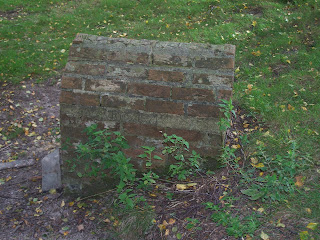
NGR: TR129582
Postcode: CT2 9AF
See postings of 8th July 2007 on this site:
Photos: http://nwiarchive.blogspot.com/2007/07/black-princes-well-harbledown.html
Description: http://nwiarchive.blogspot.com/2007/07/black-princes-well-harbledown.html
The Black Prince's Well is in the centre, about one third from bottom, at the confluence of two paths leaving the main track. Unfortunately, the woodcut shows the whole hospital complex and the well is very small. A black shadow is cast by something/someone in front of the well - which is, so far as can be told, shown as an uncontained pool emerging from a diamond shaped opening at the base of a wall (immediately above thing casting shadow). The well is clearly not set into a bank and is not below ground level - as at present.
It would not be possible to replicate this image today, as this view from the west is covered by an abandoned and overgrown cherry orchard (the fermented product of which I am drinking as I write this. However, if the woodcut is accurate, then the site was considerably different before the 1840s redevelopment, when all of the structures were demolished and the almshouses reduced in number to those in a rebuild of the long range running across the front of the church.
In fact, the landscape seems radically different to its present configuration - I walk here every day, it is about 300m from my home. The only place to the west high enough to provide the elevation from which this view was drawn is the still extant farmhouse known as Hopebourne (by the old A2 road to from London aka Watling Street - the route taken by Chaucer's Pilgrims), but historically called Hope Farm. The present Hopebourne house was constructed in the late C18th. At this time, the barn to the bottom left of the picture belonged to Brotherhood Farm, more recently called Hospital Farm. Out of picture is a stable range, now a substantial house in which my wife and I rented a flat for around three years - this complex was begun in the C16th.
















